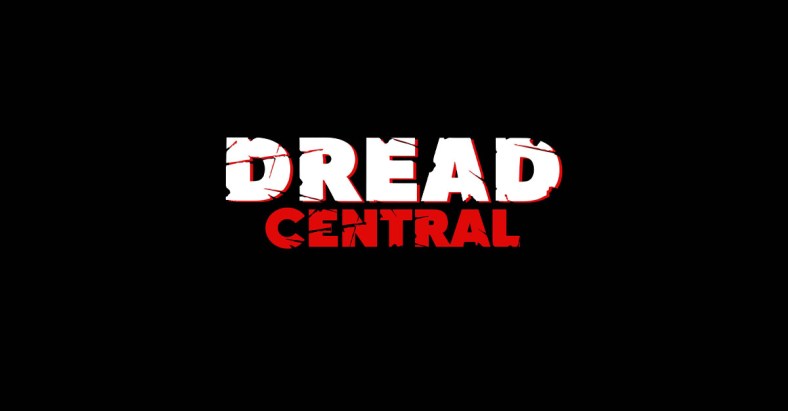Dread Central Tours Halloween Horror Nights’ The Shining Maze with Creative Director John Murdy

This past August 21 Dread Central joined John Murdy, the creative director behind Universal Studios Hollywood Halloween Horror Nights, which kicks off September 15th at Universal Studios Hollywood theme park, for a behind-the-scenes tour of the then-under-construction maze The Shining. Read on for word and exclusive photos.
Based on the seminal 1997 Stephen King book and the classic Stanley Kubrick-directed 1980 film of the same name from which it spawned, Murdy told us gleefully of his approach to the maze, situated on the lower backlot, “We’ve been wanting to do The Shining forever. In our opinion, it’s one of the great horror masterpieces of all time, and we have the added pressure (of getting it right) because of the Kubrick film, and as he’s such a legend in film, we have to stay true to his vision.”
“When we started with this, I sat down with my art director and production designer Chris Williams and we made a list of ‘must haves,’” said Murdy of their approach, “and everything that we put on that list is in the maze. The trick with this movie in making a maze based on it, is that first of all the Overlook Hotel (in which it’s placed) is so gigantic, that you can’t possibly replicate it as a façade for a maze. We kind of went through a bit of this when we did the Crimson Peak maze with Guillermo del Toro. I remember the first time I saw the house in that film, and I was like, ‘Oh god, Guillermo, it’s like one hundred feet tall,’ and you can’t scale that down to something (small), otherwise it would look like that scene in Spinal Tap where Stonehenge descends from the ceiling. So we had to come up with another way to get into the maze, and we decided to focus on the hedge mazes (from the source material) being bookends to our maze. So we see the hedge maze as the Torrance family first saw it when they arrived to the Overlook (in the film) before the storm it, and then we’ll see it after the storm hits (at the end of the maze).”
“The Shining is kind of about two things,” he mused. “You’ve got one storyline, that’s about Jack Torrance who’s played by Jack Nicholson and his descent into madness, and also this idea that somehow he’s always been a part of this hotel. There’s a weird speech at the beginning of the movie where Jack is being interviewed, and the character interviewing him feels obliged to tell him, ‘Well, we had this little problem back in 1970. We had a caretaker who was taking care of the hotel and cabin fever set in, and then he murdered his wife and two daughters with an axe, and stacked them up in the west wing.’ He’s foreshadowing what is to come.”
“The other thing that’s going on and where the book and film get their name, is this idea that Jack Torrance’s son Danny has this psychic ability that they called ‘The Shining,’ which allows himself both to see premonitions of things that have not yet happened, but also to telepathically communicate with people. And very early on, Danny starts having these visions, one of which is this door with the word ‘RedRum’ written on it, which later in the movie you realize is ‘murder’ spelled backwards.”
“So as designers,” Murdy continued, “our biggest challenge was to resist your typical Halloween theme park designer’s back of tricks, which is you know, ‘The minute you turn this corner, someone will jump out at you with an axe.’ Yes, we are going to have those moments, because you have to balance the physical scare with the psychological scare, but we also wanted to create scenes that are purely visual, that are setting up this impending sense of dread, that permeates all of Kubrick’s film. So we do that by trying to put you as the guest in the mind of Danny as he’s experiencing the story.”
Murdy then showed us examples of their approach as we toured the maze, as well as the painstaking attention to detail shown by he and his team in their creation of it, showcased during our walkthrough in everything from their replication of the very design patterns of the hotel carpeting which appeared in the film, to the strange practices of the guests in Room 237. ‘All work and no play makes Jack a dull boy’ makes a visual play within, as do the Grady twins, a 1920’s New Year’s Eve celebration, the Gold Room, that woman in the bathtub, and of course, Jack’s iconic entrance into the family quarter’s bathroom via a fireman’s axe.
For more information about “Halloween Horror Nights” at Universal Studios, visit HalloweenHorrorNights.com. Join the “Halloween Horror Nights” conversation using #UniversalHHN on Facebook at Halloween Horror Nights – Hollywood and Instagram; Halloween Horror Nights on Twitter and Periscope @HorrorNights. Add username “HorrorNights” on Snapchat for nightly live content, and watch the terror come to life on the Halloween Horror Nights YouTube Page.

Categorized:News













